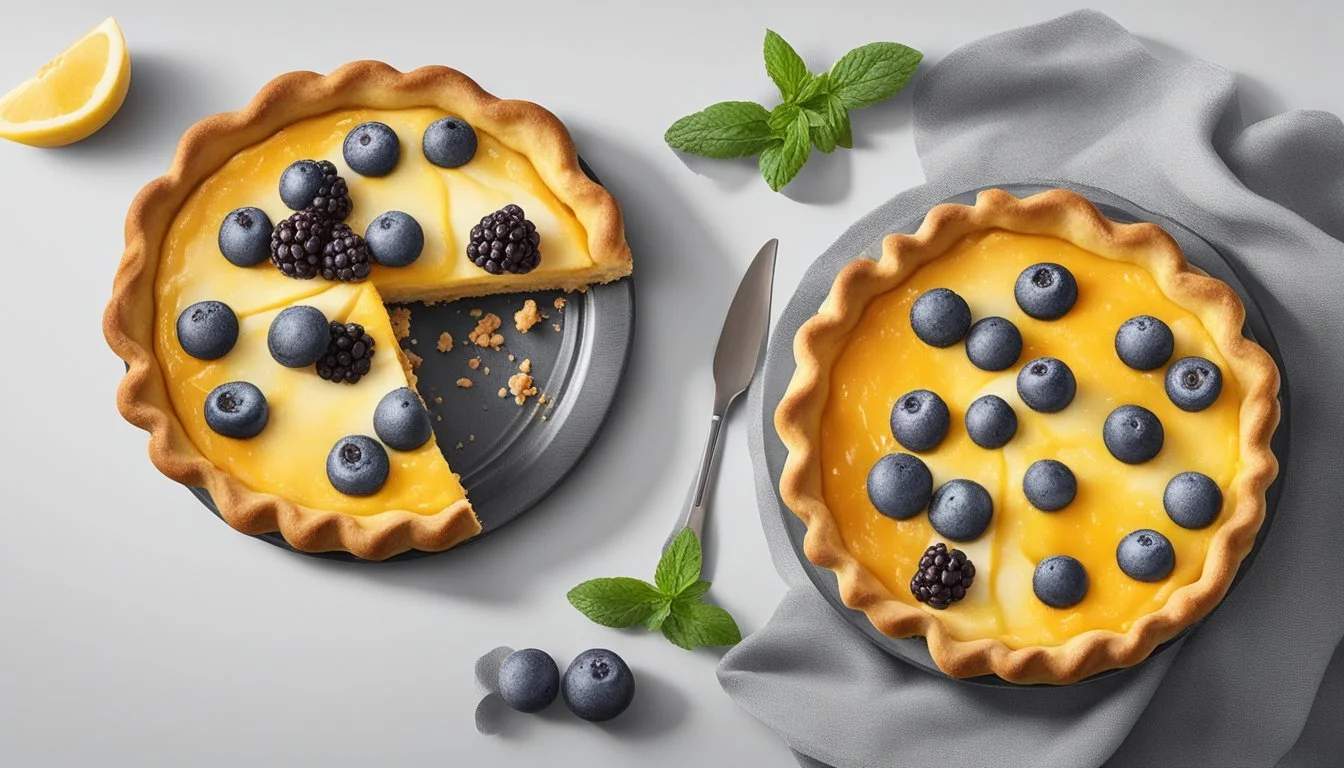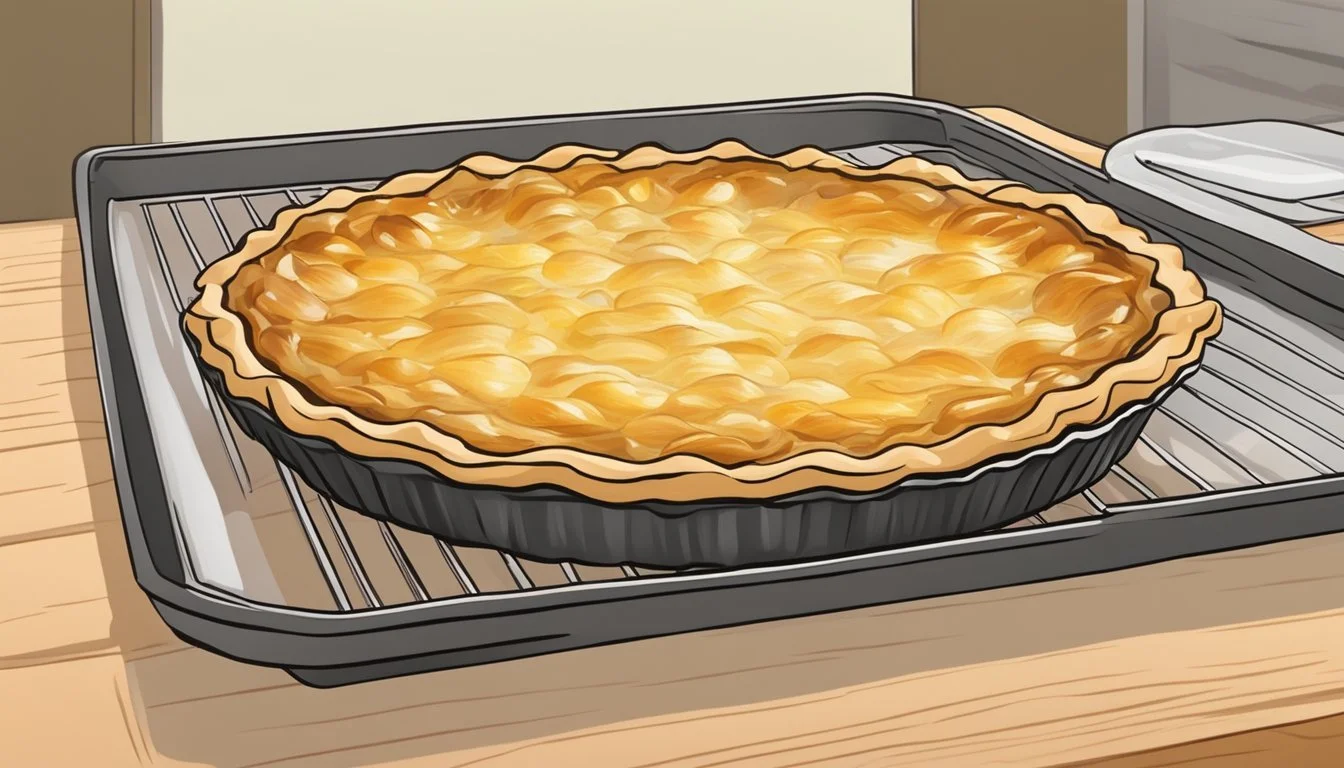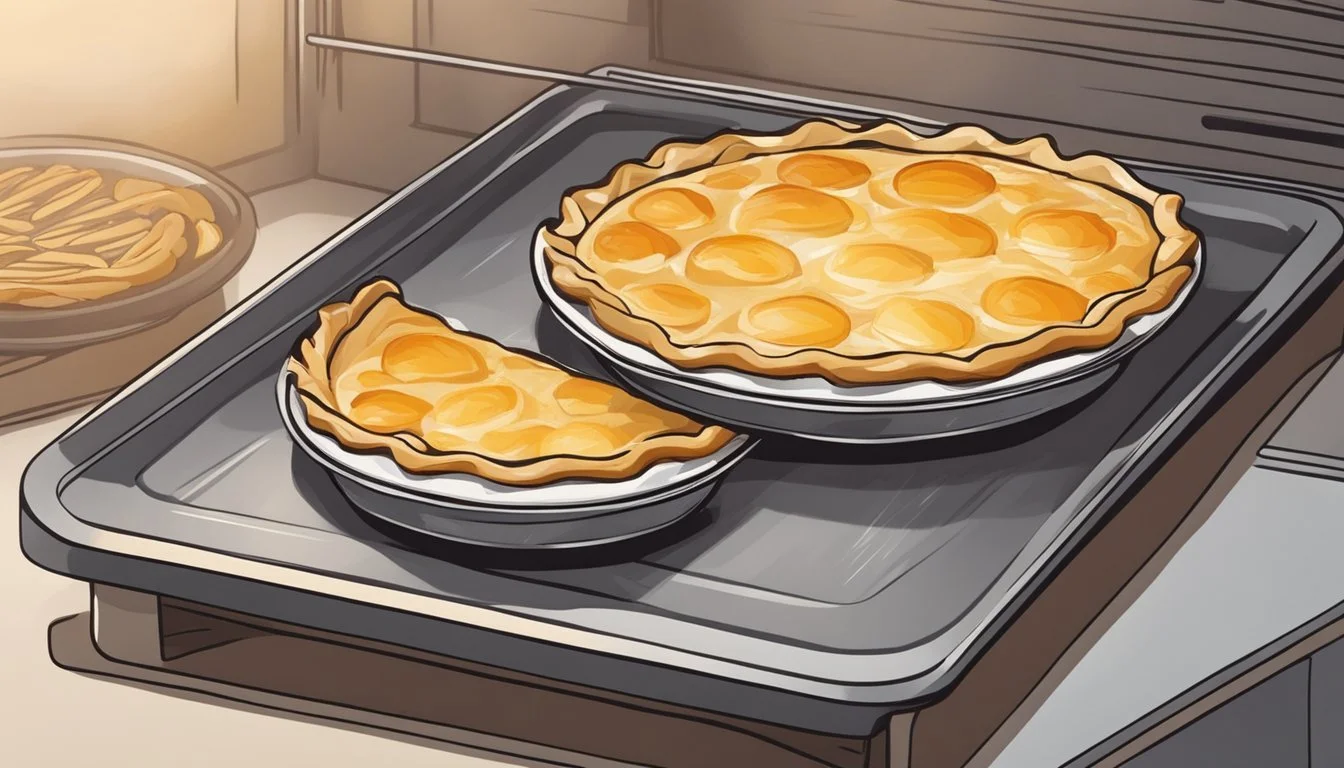Best Way to Reheat Caramelized Onion and Goat Cheese Tart
Ensuring Flakey Perfection Every Time
Caramelized onion and goat cheese tart serves as a sophisticated appetizer that combines the sweetness of slow-cooked onions with the tangy depth of goat cheese, all encased in a flaky pastry crust. The flakiness of the tart's pastry is a crucial aspect of its appeal, giving it that satisfying crunch and delicate texture. However, once the tart has been cooked and cooled, the challenge of reheating it without losing that perfect texture or compromising the melded flavors of the filling arises.
Reheating this type of tart requires careful attention to method and temperature to ensure the pastry doesn't become soggy and the filling remains delectable. Achieving the balance between a warm, inviting center and a pastry that's just as good as when it first came out of the oven is a matter of technique and timing.
Optimal reheating preserves the tart's layered textures while reinvigorating the caramelized onions' rich aroma and the subtle creaminess of the goat cheese. Using the correct heat source and covering the techniques that protect the integrity of the pastry, one can enjoy the tart in its best form, as if freshly baked.
Understanding Tart Basics
In baking, the quality of a tart is often judged by its crust and the balance of flavors within its filling. Proper preparation and reheating methods are essential to maintain these qualities.
Tart Components
A tart generally consists of a crust made from puff pastry and a filling, which in this case includes caramelized onions and goat cheese. The puff pastry is a delicate component made from layers of butter and flour which puff up during baking. The filling typically complements the buttery crust with its creamy and savory elements.
Crust: Typically, a blend of flour, butter, and water; it should be rolled to the right thickness to support the filling without becoming soggy.
Filling: A flavorful mix that can vary but usually includes a protein or cheese, and vegetables or fruits for a balance of taste and texture.
The Role of Flakiness
Flakiness in the tart crust is directly related to the puff pastry's quality and handling. It is achieved through the process of layering butter and dough before baking, which creates steam and causes the layers to rise and separate.
Puff Pastry: Must contain cold butter layered within the dough to ensure it puffs correctly and creates the desired flaky texture.
Baking: Proper baking temperature and time are critical to achieve a golden, flaky crust without overcooking the filling.
The crust should be light and airy with a golden hue, and the layers should be distinct, signifying a well-executed bake. A tart's signature texture relies heavily on maintaining these layers, which is why reheating requires careful attention to preserve the crust's flakiness.
Key Ingredients Review
The ingredients chosen for a caramelized onion and goat cheese tart are essential to both its flavor and texture. Quality goat cheese and well-caramelized onions make the dish stand out.
Goat Cheese Attributes
Goat Cheese is favored in this tart for its creamy texture and tangy flavor. The distinct taste comes from the fatty acids found in goat's milk, which differs from cow's milk. This cheese often comes in several variations - from fresh to aged - but for a tart, a softer, spreadable consistency is preferred.
Texture: Soft and spreadable
Flavor Profile: Tangy and earthy with a slight tartness
Goat cheese acts as a balancing agent against the sweetness of onions, providing a rich mouthfeel when melted. It's essential to select cheese that isn't overly aged or hard as it needs to blend smoothly with the other ingredients such as eggs and cream for the filling.
Caramelized Onions: A Flavor Journey
Caramelized Onions encapsulate a perfect blend of sweetness and savory notes, attributed to the Maillard reaction occurring during the slow cooking process. Sweet varieties like Vidalia or Walla Walla are excellent choices as their inherent sugar content caramelizes well. Red and Yellow onions are also suitable options due to their robust flavor profiles.
Best Onion Types: Sweet, Red, Yellow, Vidalia
Cooking Method: Slow-cooked until brown and soft
The process involves consistent heat and elements such as olive oil, salt, and fresh thyme to enhance taste. As onions gradually transform, they develop a deep, golden-brown color, releasing complex flavors that are both sweet and umami-rich. The presence of salt is crucial, as it draws out moisture and aids in even caramelization.
By following these fundamental ingredient choices and cooking methods, one ensures the tart's filling is flavorful, with a pleasing contrast in textures between the silky goat cheese and the sumptuously rich caramelized onions.
Preparing the Tart
Before reheating the caramelized onion and goat cheese tart, ensuring proper initial preparation is essential to maintain the desired flakiness and texture.
Working with Puff Pastry
When using frozen puff pastry, it is crucial to thaw it properly. One should remove the puff pastry from the freezer and allow it to thaw in the refrigerator for several hours, or overnight. Once thawed, they can carefully unfold the pastry without breaking it. If using store-bought pastry, adhere to the package's thawing instructions closely. If rolling is required, do so on a lightly floured surface, and for homemade recipes, one should aim for even thickness to ensure uniform baking.
Assembling the Tart
The oven should be preheated to the temperature specified in the recipe, commonly around 400°F (200°C). They should then line a baking sheet or tart pan with parchment paper to prevent sticking and to make it easier to transfer the tart after baking. After the puff pastry is laid out on the prepared sheet or pan, a boundary should be scored around the edge to create a crust, and fork tines can be used to dock the pastry inside the border.
The mixture of caramelized onions, which should be at room temperature, gets evenly spread onto the pastry within the scored borders, followed by crumbled or sliced goat cheese on top. To add a glossy finish and to help with browning, one can brush an egg wash (a beaten egg mixed with one teaspoon of water) over the edges of the puff pastry.
Proper initial assembly guarantees the caramelized onion and goat cheese tart will reheat successfully while maintaining the integrity of its delicate, flaky layers.
Reheating Strategies
When reheating a caramelized onion and goat cheese tart, one must consider both the preservation of the flaky texture of the crust and the desired warm, golden-brown finish. The key to success lies in the careful management of temperature and technique.
Preheat Techniques
To ensure an even and effective reheat, preheating the oven is an essential first step. One should:
Preheat the oven to 350°F (175°C).
Allow the leftover tart to come to room temperature before placing it in the oven, which can prevent the crust from becoming soggy due to sudden temperature changes.
This process assists in warming the tart gradually, which is crucial for maintaining the quality of the pastry.
Maintaining the Tart's Integrity during Reheat
Cover the tart loosely with foil to protect the filling and prevent the crust from burning or getting too brown.
Place the tart on a baking sheet for stability and consistent heat distribution.
Reheat for about 10-15 minutes, checking occasionally, until it's warmed through and the crust retains its texture.
By adhering to these strategies, the reheated tart will not only be heated through but will also preserve the flakiness of its crust, ensuring that it is remarkably similar to its freshly baked state.
Nutritional Considerations
When considering the reheating of a caramelized onion and goat cheese tart, one should take into account not only the sensory quality of the appetizer but also its nutritional impact. This section covers the caloric information and dietary benefits related to this dish.
Caloric Information
A standard serving size of caramelized onion and goat cheese tart typically contains a significant number of calories, largely due to the presence of puff pastry and cheese. The exact calorie count can vary, but one must be mindful of portion sizes when consuming this rich appetizer. A common breakdown for an average slice (1/8 of a full tart) might look like the following:
Total Calories: Approximately 250-400 kcal
From Carbohydrates: 50-70% of total calories
From Fats: 25-40% of total calories
From Proteins: 10-20% of total calories
Dietary Benefits
While the tart is calorie-dense, it also offers nutritional benefits. It contains goat cheese, which is a source of protein and can be easier to digest than cheese made from cow's milk. The onions, when caramelized, not only add flavor but also provide vitamin C and dietary fiber.
Goat Cheese: Source of calcium and protein; lower in lactose
Onions: High in vitamin C, antioxidants, and fiber
Note: If the tart is prepared using a food processor to blend the filling, it is important to ensure that no additional ingredients high in calories or fat are unnecessarily added, which could alter the nutritional profile of the dish.
Optimal Serving Suggestions
To fully appreciate the flavors of a reheated caramelized onion and goat cheese tart, one must consider the best sides and presentation methods. The combination of the warm, flaky crust with the savory sweetness of the onions and the creamy tang of the goat cheese makes it ideal for discerning palates.
Complementary Sides
When serving caramelized onion and goat cheese tart, one should aim to balance the richness of the tart with lighter sides. A simple arugula salad, dressed with a lemon vinaigrette, adds a fresh and peppery component. For a hearty companion, try roasted root vegetables or a side of grilled asparagus to complement the tart's flavors. Here's a suggested list of sides that pairs well with the tart, especially when served at brunch, lunch, or as a holiday appetizer:
Arugula salad with lemon vinaigrette
Roasted root vegetables
Grilled asparagus
Couscous (What wine goes well with couscous?) or quinoa for a grain option
Presentation Tips
Presentation is key in elevating the caramelized onion and goat cheese tart from a simple dish to an appetizer worthy of any holiday party or special event. For an appealing setup, one may opt to serve the tart as tartlets, which make for individualized portions easy to distribute among guests. To accentuate the visual appeal, garnish the tart with small sprigs of fresh thyme just before serving.
Here are specific tips to ensure the tart looks as good as it tastes:
Cut the tart in even, clean slices for uniform servings.
Serve tartlets on a platter garnished with fresh herbs for an elegant touch.
Add a sprinkle of coarse sea salt atop the tart to enhance both flavor and texture.
For holiday gatherings or formal events, the presentation should mirror the occasion's sophistication, with garnishes and plating that reflect the celebratory mood.
Storing the Tart
Proper storage of a caramelized onion and goat cheese tart is essential for preserving its taste and flakiness. One can choose between short-term refrigeration to enjoy the tart within a few days, or employ long-term freezing methods if they intend to save it for a later date.
Short-term Storage Tips
For short-term storage, one should let the tart cool to room temperature to prevent condensation. Once cooled, it can be wrapped tightly with cling film, but for added protection, placing a layer of parchment paper over the tart before wrapping can help maintain its texture. The tart should then be stored in the fridge, ideally in an airtight container, and consumed within 3 to 4 days for the best quality.
Cool Tart: To room temperature before storage.
Wrap: Tightly in cling film with a layer of parchment paper.
Refrigerate: Place in an airtight container in the fridge.
Consume: Within 3 to 4 days.
Long-term Freezing Methods
If one opts for long-term storage, the tart can be frozen. After the tart cools, it should be wrapped first in parchment paper and then in foil to avoid freezer burn and taste alteration. Labeling the package with the date will help track how long it has been stored. Properly wrapped, the tart can be kept in the freezer for up to 2 months. To thaw, the tart should be placed in the fridge overnight before reheating.
Wrap: In parchment paper, then in foil.
Freeze: Place in the deepest part of the freezer.
Label: With the current date.
Thaw: In the fridge overnight before reheating.
Store: For up to 2 months.
Enhancing Your Tart
To elevate a caramelized onion and goat cheese tart, thoughtful additions and flavor tweaks can make a significant impact. From strategic garnishes to intentional variations of the base flavors, the potential for a more luxurious and taste-focused experience is significant.
Adding Garnishes
A garnish serves not only as visual appeal but can also enhance the overall flavor profile.
Fresh Herbs: Sprinkling finely chopped fresh rosemary or other herbs provides an aromatic touch.
Balsamic Glaze: A drizzle of balsamic glaze adds a tangy sweetness that complements the richness of the caramelized onions.
Asparagus Tips: For added texture and a hint of freshness, blanched asparagus tips make a delightful garnish.
Flavor Variations
Introducing new flavors can transform the tart, making it suitable for a range of palates and occasions.
Onion Variety: Using red onions offers a deeper sweetness when caramelized in a saucepan, infusing a robust flavor.
Infused Honey: A drizzle of rosemary-infused honey over the tart introduces a subtle, earthy sweetness.
Grilled Vegetables: For more depth, adding grilled vegetables, such as asparagus, on skewers as a side can create a more rounded meal.
Miscellaneous Tips and Tricks
To ensure that reheating a caramelized onion and goat cheese tart maintains its texture and flavor, one must approach it with careful technique.
Avoiding Common Mistakes
Heated improperly, the tart can become soggy or unevenly warm. Below are key mistakes to avoid:
Avoid Microwave Use: A microwave can make the tart crust soft and chewy instead of flaky. It is advised to use an oven or toaster oven for reheating.
Skip the Rush: Allowing the tart to reheat gradually prevents the crust from becoming too tough or the filling from drying out. Reheat at a moderate temperature.
Utensils and Cookware for an Ideal Preparation
Choosing the right utensils and cookware can significantly impact the texture and evenness of reheating your tart.
Skillet
Cast Iron Skillet: For caramelizing more onions or reheating slices of tart, a large skillet, particularly cast iron, is beneficial for its even heat distribution.
Skillet with a Lid: When using a skillet to warm the tart, cover it with a lid to trap heat and moisture, ensuring even reheating.
Utensils
Tart Pan: A tart pan with a removable bottom is excellent for reheating as it allows for easy release without damaging the crust. Place it directly in the oven.
Cookware for Preparation:
Saute Pan: Use a saute pan to caramelize additional onions or shallots, incorporating flavors such as garlic, thyme, or sage.
Food Processor: If incorporating ingredients like cream cheese or creating a base for the filling, a food processor ensures a smooth and even mixture.
Using proper tools and methods optimizes the reheating process, preserving the flakiness of the tart crust and the integrity of its savory filling.
Serving for Special Occasions
When it comes to special occasions, the caramelized onion and goat cheese tart offers a harmonious blend of savory flavors perfect for elevating any festive menu. Its delicate flakiness is best preserved with proper reheating techniques.
Tarts for Holiday Menus
Thanksgiving and Christmas are holidays steeped in culinary tradition, and a caramelized onion and goat cheese tart fits right in. They should consider the following for a successful holiday spread:
Presentation: Serve the tart on a festive platter that complements the golden-brown crust.
Pairing: For Thanksgiving, this tart pairs wonderfully with cranberry relish, adding a sweet and tart contrast to the savory filling.
Temperature: Ensure the tart is reheated gently in an oven at a low temperature to maintain its flakiness, avoiding the microwave which can render the pastry soggy.
The key is to aim for a balance of flavors that complements the existing holiday table without overpowering it.
Tart as a Party Favorite
At any party, a caramelized onion and goat cheese tart offers an elegant appetizer option that's both sophisticated and approachable. Party hosts should note:
Sizing: Opt for tartlets if guests prefer finger foods, making it easy for guests to enjoy a bite-sized version of this classic dish.
Preparation: To maintain the integrity of the whipped goat cheese topping, consider adding it fresh on top of the reheated tart base just before serving.
Variants: Experiment with different types of onion, such as red onions for a touch of sweetness, or add herbs like thyme to the whipped goat cheese for an extra layer of flavor.
Whether it's served as a larger quiche (What wine goes well with quiche?) -style tart or as mini tartlets, this dish's versatility makes it suitable for any party situation.












